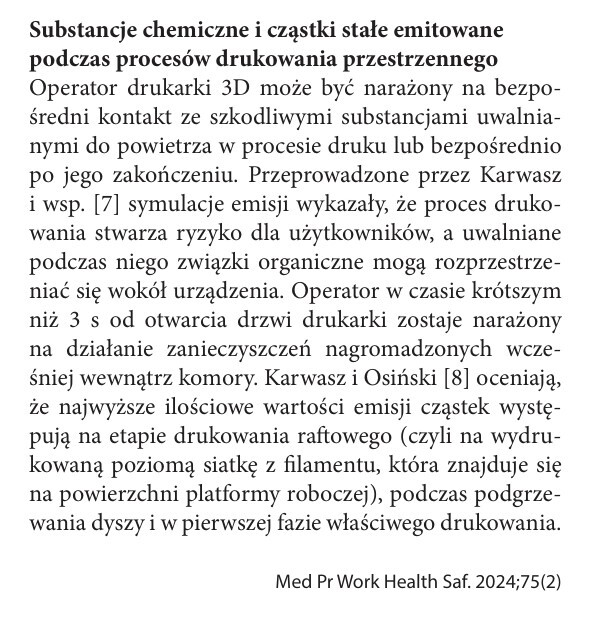Online first
Current issue
Archive
Most cited in 2024
About the Journal
Editorial Office
Editorial Board
Copyright and self-archiving policy
Information clause on the processing of personal data
Declaration of accessibility
Instructions for Authors
Instructions for Reviewers
Contact
Reviewers
2024
2023
2022
2020
2021
2019
2018
2017
2016
2015
2014
2013
Editing and translations
REVIEW PAPER
Risk assessment and toxicity effects of materials used during additive manufacturing with FDM technology
1
Centralny Instytut Ochrony Pracy – Państwowy Instytut Badawczy / Central Institute for Labour Protection – National Research Institute, Warsaw, Poland
Zakład Zagrożeń Chemicznych, Pyłowych i Biologicznych / Department of Chemical, Biological and Aerosol Hazards
Online publication date: 2024-03-22
Corresponding author
Elżbieta Dobrzyńska
Centralny Instytut Ochrony Pracy – Państwowy Instytut Badawczy, Zakład Zagrożeń Chemicznych, Pyłowych i Biologicznych, Czerniakowska 16, 00-701 Warszawa
Centralny Instytut Ochrony Pracy – Państwowy Instytut Badawczy, Zakład Zagrożeń Chemicznych, Pyłowych i Biologicznych, Czerniakowska 16, 00-701 Warszawa
Med Pr Work Health Saf. 2024;75(2):159-71
KEYWORDS
TOPICS
ABSTRACT
This paper discusses the potential of additive printing, the risks it poses to users’ health (including 3D printer operators) and the effects of chemical substances released during the printing based on the available in vitro and in vivo studies. It was shown that substances emitted during printing with the commonly used acrylonitrile butadiene styrene filament in additive manufacturing might have carcinogenic, hepatotoxic and teratogenic effects, as well as toxic effect on the respiratory system. The latest research on the mechanism of formation of particles and volatile organic compounds during 3D printing, the parameters affecting their potential emission, and trends in reducing these hazards are indicated. The need for the design of more environmentally friendly and less emissive printing materials, as well as strategies for prevention and individual and collective protection measures are emphasized. Users of 3D printers should be familiar with all possible aspects of the threats associated with the printing process. Insufficient data on direct exposure to chemicals and particles released during the use of filaments makes it difficult to build awareness of safe working practices. Of particular concern is the health impact of emitted chemicals and particles from thermally treated materials in one of the most popular technologies for 3D printing, i.e., fused deposition modelling. Exposure of the users to, e.g., plasticizers added to filaments occurs through a variety of routes, by absorption through the skin, by inhalation or ingestion. Available epidemiological data, as well as current experimental works, indicate that such exposure is a high risk of cardiovascular diseases, atherosclerosis in adults, and cardiac problems and metabolic disorders in children. This review, by identifying potential risk factors, may contribute to reducing the health loss of printer users and improving working conditions and safety, especially in enterprises where additive manufacturing technology
is used. Med Pr Work Health Saf. 2024;75(2):159–171
Share
RELATED ARTICLE
We process personal data collected when visiting the website. The function of obtaining information about users and their behavior is carried out by voluntarily entered information in forms and saving cookies in end devices. Data, including cookies, are used to provide services, improve the user experience and to analyze the traffic in accordance with the Privacy policy. Data are also collected and processed by Google Analytics tool (more).
You can change cookies settings in your browser. Restricted use of cookies in the browser configuration may affect some functionalities of the website.
You can change cookies settings in your browser. Restricted use of cookies in the browser configuration may affect some functionalities of the website.






